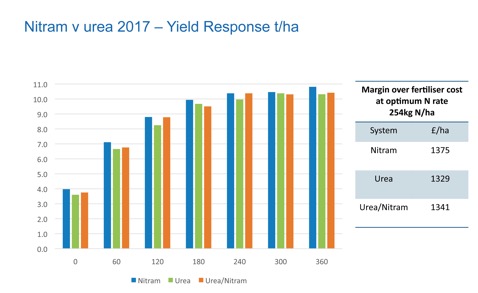AN delivering extra yield
8th December 2017
Straight 34.5%N produced an extra 0.4t/ha of milling wheat over crops using a urea fertiliser as their only source of nitrogen in 2017 according to new trial results announced by CF Fertilisers at CropTec 2017.
Straight 34.5%N produced an extra 0.4t/ha of milling wheat over crops using a urea fertiliser as their only source of nitrogen in 2017 according to new trial results announced by CF Fertilisers at CropTec 2017.
Carried out by Armstrong Fisher Ltd in Helpston, Cambridgeshire, the trials showed ammonium nitrate (AN) outperformed urea with the extra margin over fertiliser costs at optimum application rates being worth an extra £46/ha, says trial manager Dr. Mike Armstrong.
“There was a significant yield advantage in favour of AN across all plots in the trial. Even where urea was used as an early application and then followed by AN, there was a 0.25t/ha drop in yield compared with crops given all their nitrogen as AN.
“This means that even using urea in the often thought of safe early application timing and following it with AN would have cost growers £34/ha over the full AN programme, which over 100ha of wheat adds up to a sizeable £3400 loss.”
When comparing a full urea programme to a full AN one, the loss is even greater at £4600 over 100ha, he explains.
“We wanted to look at all possible scenarios of urea use versus AN so as well as a direct comparison of the two, we also decided to test the idea that urea can be a safe, lower-cost early application.
“An application of 50kg N/ha of urea was applied in these instances with remainder of the fertiliser application being made up of 34.5% Nitram AN.”
A range of application rates up to 360kg N/ha were used with the optimum rate found to be 254kg N/ha. At this rate, the AN crops were producing 10.3t/ha whilst the urea ones were at 9.9 t/ha, Mike Armstrong points out.
“Using representative prices of £0.58p/kg for AN, £0.43p/kg for urea and a wheat price of £140t/ha with a £20/t full premium and £10/t partial premium, highest margin was the full Nitram application programme at £1375/ha.
“This was followed by the urea/AN combination at £1341/ha and £1329/ha for the urea only programme.”
According to CF Fertilisers arable agronomist Allison Grundy, the results confirm the superior performance of AN as a main fertiliser choice but also cast doubt on the role of urea as a safe and economical early application.
“I think we have to increasingly think of urea in terms of the potential it can offer and the reality of it being able to deliver this in UK conditions.
“With moist soil, low air temperatures and sufficient rainfall after application, there’s a chance urea will perform as well as AN.
“If the combination of soil and environment conditions affect the process of urea converting to its available N form, growers are likely to lose out. So why take the risk?”
The Armstrong Fisher results align with those from ADAS showing that 8 times out of 10 urea underperforms against AN with the remaining 2 offering equivalent or enhanced performance against AN, she says.
“The ADAS researchers also showed AN in the shape of Nitram gave a 0.4% improvement in grain protein content compared to urea.”

